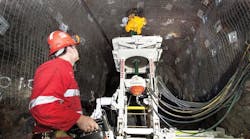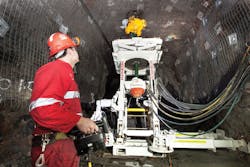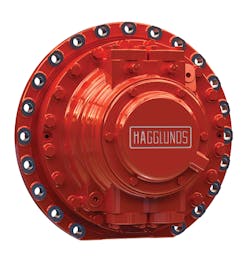This file type includes high resolution graphics and schematics when applicable.
Mines for precious metals usually consist of a series of horizontal tunnels cut in strategic locations, each chosen to extract the greatest amount of ore with the least amount of excavation. Often, however, large pockets of ore are located in a less accessible area well above a tunnel—an area called the back. It is usually not cost-effective to bore a separate tunnel to reach deposits in the vein, so a boxhole drill is brought in to bore upward into the back.
Boxhole drills come in a variety of sizes and designs, but the most useful ones are relatively small, yet powerful — characteristics that usually cannot co-exist. Nevertheless, “compact” and “powerful” define the Redbore 30 boxhole drill, designed and built by J.S. Redpath Ltd., North Bay, Ontario, Canada. Because the Redbore 30 is so compact, mine operators can forego the expense of drilling an auxiliary tunnel to reach the overhead body of ore.
In spite of its small footprint, the Redbore 30 packs as much power and torque as its bulkier competitors. The difference is that the Redbore 30 uses a direct-drive hydraulic motor that transmits low-speed, high-torque power without the need for a planetary gearbox.
Direct Advantages
The Redbore 30 uses Hägglunds CA 140-120 direct-drive hydraulic motor from Bosch Rexroth. Because the motor has a short axial length, it is an integral part of the vertical shaft drive of the boxhole drill. The CA 140-120 occupies little volume because it has no planetary gearbox, couplings, or foundations, which would otherwise consume additional space. In addition, the motor is designed and constructed to withstand the high shock loading inherent to this application.
Depending on the application and conditions, the Redbore 30 can drill directly to the ore pocket or first drill a pilot hole, followed by reaming. In either case, the rotary drive operates at variable speed up to only 15 rpm and operating torque of 20,000 lb-ft (27.1 kN-m). Maximum torque is 22,000 lb-ft (29.8 kN-m), and operating pressure is 3,000 psi (20,670 kPa). Hydraulic cylinders also operate at pressure to 3,000 psi to provide up to 100,000 lb (444 kN) of thrust to power the drive upward.
Rick Pearson, Redpath’s shop foreman, explained that the Redbore 30 had a long list of engineering requirements for the firm’s developers to fulfill. The drill had to occupy as little space as possible while being rugged, delivering great power, and drilling upward into the rock. The same was true for the components.
With regard to the drive technology, those requirements are exactly why the choice fell to the compact Hagglunds direct drive hydraulic motor. Redpath’s experience with this motor has been excellent. “The Hägglunds is the proven Cadillac of high-torque, low-speed hydrostatic drives on the market,” added Pearson.
Versatility in Action
When designing the Redbore 30, it was the compact and lightweight construction of the hydraulic motor that was the deciding factor. “The Hägglunds drive changes the Redbore 30 from a typical requirement of mining to a profitable production machine,” Pearson emphasizes.
Another contribution is made by a through shaft. During the drilling process, it is possible to cool the piloting and reaming bits with air and water. This ensures that the compact Redbore 30 always keeps a cool head as it cuts through the rock at variable speed, all the while applying high torque with torque limiting.
Joe Pegg is with Bosch Rexroth Canada Corp., Canada. For more information on Hagglunds hydraulic motors and other products and services, click here.
Boxhole Drill Uses Dual-Displacement Motor
The Hägglunds Series CA motor was developed for applications requiring high-torque, low-speed motors where small size, light weight, and the ability to handle shock loading are important issues. The result is a compact hydraulic drive with that shares the same benefits as other Hägglunds motors from Bosch Rexroth. The CA motor also features multiple mounting options and a useful through-hole shaft design.
The CA 140-120 motor used in the Redbore 30 is a dual-displacement model. It operates at either 7,543 or 3,771 cc/rev for maximum speeds of 120 or 60 rpm, respectively. At the operating pressure of 3,000 psi (207 bar), the CA14-120 transmits 24,840 N-m of torque in or full-displacement mode or 12,420 N-m at low displacement.
This file type includes high resolution graphics and schematics when applicable.




